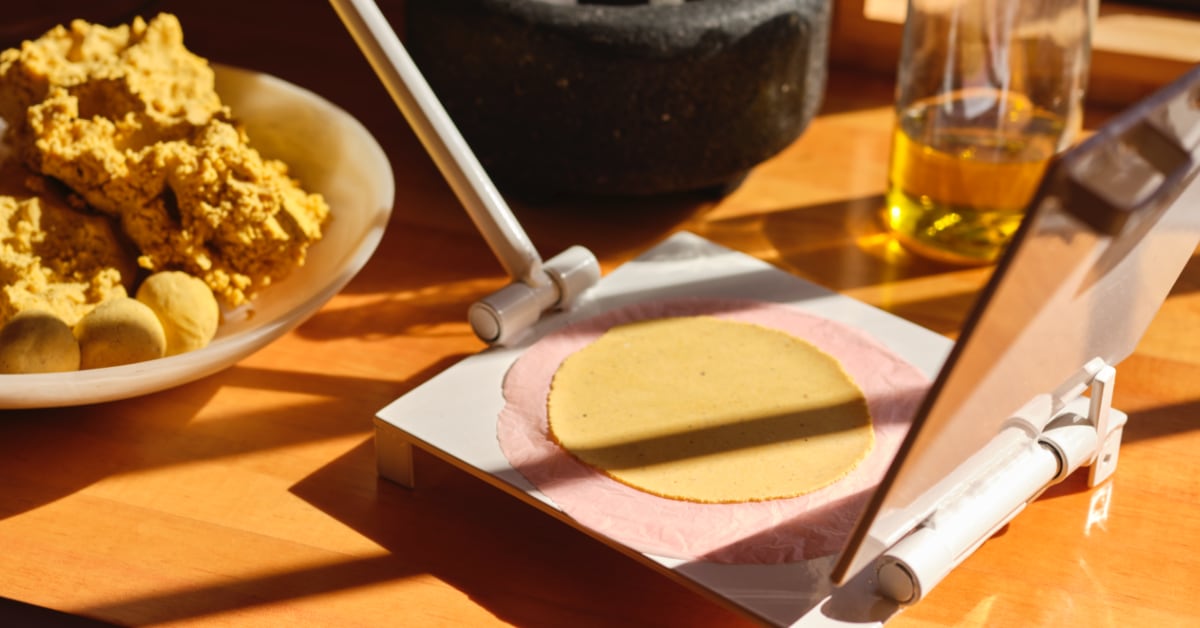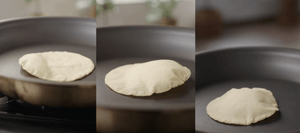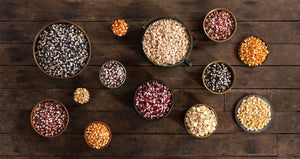A Guide to Masa Harina
A Guide to Masa Harina

July 13, 2022
Masa harina is an ingredient often cited in recipes and referenced casually in conversation and comments as the trick to making the BEST tortillas with little to no effort. That said, its utility extends well beyond the tortilla. Masa harina will have you on your way to homemade tamales, tetelas, sopes, tlayudas ... all of the masa creations your appetite can imagine.
The humble corn kernel has been transformed into many different products, but we're here to clear things up: masa harina is one of the most nutritious and ancient applications. For more about what masa harina is, how it differs from other corn flour products, its health benefits and how to use it to make perfectly puffy corn tortillas, read on.
So What is Masa Harina?
Not to be confused with masa (the dough form), masa harina translates from Spanish to "dough flour." More than just ground corn flour, masa harina is a dehydrated and milled form of the wet, clay-like masa (made from nixtamalized corn kernels) that is used to make authentic corn tortillas. Corn is cooked, slowly dried and milled to preserve its deep flavor and wholesome texture.
While freshly ground masa has a shelf life of a day or two and should be frozen for longer storage, masa harina is shelf-stable and requires only water to rehydrate it into fragrant, delicious dough for cooking.
But do a little digging and the scene gets a bit more muddled:
So is it just ... dried corn dough?
Yes, but also, not quite. The corn used to make this dough has undergone a complex process called nixtamalization, the process of soaking (also referred to as ‘cooking’) whole-kernel heirloom corn (aka raw, dried masa corn kernels) in calcium hydroxide (or simply, ‘cal’ in Spanish) before those re-hydrated kernels are then run through a grinder of some sort.
But it's a powder that I add water to, yes?
That's slightly more accurate, but we cringe at the word powder and prefer...grains of magic. And yes, all you need for perfect corn tortillas is a bag of high-quality masa harina (or 'masa flour') and water.
Is it really worth buying a bag just to make tortillas?
Beyond perfecting your own technique and desired masa consistency to tortilla thickness ratio, the aroma, flavor and ‘wow’ factor of heirloom corn tortillas is truly minutes away once you start the process.
Masa-based foods abound all over Latin America: tacos and tlacoyos in Mexico, arepas in Venezuela and Colombia, pupusas in Honduras, and much more. And now that masa harina is easily accessible to the home cook, you can feel free to get creative with its uses. Just imagine the mas-opportunities!
How We Make Masa Harina at Masienda
Masienda Heirloom Masa Harina begins with single-origin heirloom corn sourced from Mexico.
This whole-kernel corn is gently cooked and steeped in soaked in lime water (alkaline), an ancient technique known as nixtamalization. This process softens the corn, imparts calcium and activates the nutrients, especially vitamin B3, found naturally in each kernel.
The kernels (now nixtamal) are then ground into a fine masa, or dough. For Masienda Heirloom Corn Masa Harina, it undergoes a low-and-slow drying process, which is used to make a finished, shelf-stable product that carefully preserves the flavor and nutrients of a freshly-milled masa.
With the simple addition of warm water, the masa is transformed into the foundation for hundreds of dishes, including making tortillas, tamales, tostadas and other delicious recipes.
Our masa harina delivers superior flavor (thanks to our single-origin supply chain and culinary, never industrial approach to sourcing), consistency (we individually dial in the cook, nixtamal and grinding processes for each scratch-made batch) and ease of use – just add water!
What's the Difference between Masa Harina, Cornmeal and Cornstarch?
The important differentiator between cornmeal and masa harina is that cornmeal results from the grinding of dried field or ‘dent’ corn. In other words, corn that has not undergone nixtamalization. Masa harina results from the grinding of corn that has been prepared via the nixtamalization process we explain above. Cornmeal tends to be coarser than masa harina. While we do not recommend using cornmeal to make tortillas, masa harina can be used in many recipes that call for finely ground cornmeal (think: great in baked goods like cornbread or muffins, but won't do much to prevent your pizza dough from sticking to the pizza stone).
Cornstarch is also derived from corn, but it undergoes a process whereby the protein and the fiber are removed (whereas masa harina is made from whole-kernel, nixtamalized corn). Cornstarch is often used as a thickener in soups and stews, and although masa harina is a totally different product, it can also be used as a thickening agent.
Photo credit Graydon Herriott
Masa Harina vs Maseca
Because of both marketing dollars and simple monopolistic mechanics, today most people substitute Maseca, a brand name, for masa harina. (Think Xerox or Post-It, but we digress.)
Maseca is the mass-produced form of masa harina from Mexican multinational masa flour and tortilla manufacturing company, Gruma, which was introduced to the Mexican food marketplace in 1949 before launching in the United States in 1977. It's like the Folgers or Bisquick of masa: a quick-fix alternative to a traditional, lengthy process. Traditional masa can take as long as twelve hours to prepare. Masa harina, by contrast, is instant; just add water, mix, and . . . masa.
While we owe a debt to Maseca for ushering in an era of convenience, value and mass consumption of "homemade" corn tortillas, the cost of this culinary innovation has manifested in countless ways, least of which include the sacrifice of taste and flavor of the finished product. This is a topic we get into at length in Masienda founder Jorge Gaviria's new book, MASA.
While most commercial masa harina producers like Maseca employ a similar process to the traditional method of making masa (slow food), there are modifications to the system that allow manufacturers to manipulate the masa’s presentation and/or accelerate the process, thereby saving money and maximizing margins (fast food).
To manipulate color, white corns are typically degermed before nixtamalization, which reduces the natural nutrient density of the corn. Some large-scale manufacturers of masa harina often also bleach the corn with citric acid or phosphoric acid to achieve the most pure white masa possible (white masa harina making up about 60 percent of the market). Finally, the masa is flash dried in a furnace at temperatures upward of 750°F for about 4 seconds, which can lead to a denaturing of the masa’s nutrients.
Most masa harina is manufactured for food service use, primarily tortillerias and snack producers. According to one industry insider, the best masa harina goes to these customers, while the “seconds” (that is, the heads and tails of production, usually of lower quality) are packaged and distributed to the retail market. Since its introduction to the United States and Mexico in the early and mid-twentieth century, respectively, masa harina has competed directly with the traditional method of masa production, leading to an enormous shift in the way masa is accessed across the world. Of course, there are both pros and cons to this convenience.
In a nutshell, Maseca has dominated the masa harina/corn flour/instant market for decades, confusing countless well-intentioned, quality-seeking at-home cooks and restaurant chefs alike.
What's the Difference Between Masa Harina, Masa Flour, Corn Masa and Corn Flour?
Of this group, they are all interchangeable, minus corn flour. Depending on the context of the reference, each of these terms is simply a different combination of English, Spanish and colloquial speech.
Corn flour may refer to masa harina, but can also be used to refer to finely milled dried corn that has not been nixtamalized. Unlike cornmeal's gritty texture, corn flour is fine and powdery.
Health Benefits of Masa Harina
Masa harina has many health benefits that make it essentially a superfood. It’s much higher in fiber and magnesium than its refined wheat flour counterpart. It is rich in niacin, an essential B vitamin that converts food into energy and aids a healthy nervous system. Niacin is thought to help lower cholesterol, support DNA repair, ease arthritis, and even boost brain function. Through the process of nixtamalization, corn is soaked in food-grade calcium hydroxide. This lime-treated corn is a great source of calcium, which helps with the digestion and absorption of niacin. Additionally, calcium aids in our absorption of vitamin D, a key function in bone health.
How to Make Masa for Tortillas Using Masienda's Masa Harina
For starters, our golden ratio here at Masienda is 1:1 (i.e. one packed cup of Heirloom Corn Masa Harina: one scant cup of warm — not boiling —water).
Slowly add the water to the dry masa flour in a large bowl, stirring the masa to incorporate evenly by hand (you may also choose to use a standup mixer with paddle extension). Knead until the water is evenly incorporated and no dry, powdery spots remain. Add salt, spices and seasonings to taste (optional), evenly incorporating throughout finished masa. If aiming for a masa for tortillas, you want a finished masa that is moist to touch, but not tacky (leaving bits of wet masa on your hand and fingers).
Once prepared, use immediately, or rehydrate with additional water before use (if waiting several minutes before use).
Making Tortillas The Right Way:
-
For additional hydration during the tortilla cooking process, we recommend using a spray bottle/mister to lightly hydrate each side of the tortilla (to prevent dryness and cracking).
-
Warm water (~100 degrees F, or the hot setting on your faucet) is recommended, in order to begin blooming the natural flavor of the masa and to fully activate the small bits of pericarp (corn skin) in the masa flour (which help the masa bind, naturally).
-
Water can be substituted with other liquids such as stocks, broths, juices etc., depending on the desired flavor. Spices may also be added. Masienda respects tradition while encouraging creativity for all cooks.
-
1 lb of Heirloom Corn Masa Harina yields approximately 2.4 lb of service-ready masa (38 tortillas, weighing 1 oz each before cooked—84 tortillas in each 2.2 lb bag of Masienda Heirloom Corn Masa Harina.
-
See the printable recipe at the bottom of the post, and let us know your thoughts!
Which Color of Masa Harina is the Best?
Different colors of masa harina relate to the color of the corn they come from. White masa harina comes from white corn kernels, yellow from yellow corn, blue from blue, and red from ... you guessed it! Red. You can use any color masa for any masa application, but there are subtle differences in flavor and texture that lend themselves better to different types of recipes.
Our white masa harina is perhaps the most versatile option: it features a light, floury starch for a pillowy table tortilla and a dense enough body for making perfect tostadas, totopos and recipe tortillas (i.e., tortillas meant for enchiladas, enfrijoladas, etc.) that don’t absorb too much oil when fried. It has a slightly higher natural oil content, making for a more concentrated, decadent corn flavor that lingers on your palate.
For deep yellow color and a denser starch content to support the structure of larger tortillas, yellow masa harina (milled from Yellow Tuxpeño corn grown in Chiapas), is our go-to. With its sweet, vegetal notes that bring to mind carrots and butternut squash, it might be the most flavorful varietal out there, and always has a lovely toothsome finish.
Blue corn masa harina is the go-to for table tortillas across Mexico, in states like Oaxaca, Tlaxacala and Estado de México. Featuring a light starch density and sweet, grassy flavor profile, our blue masa harina from Blue Cónico corn creates a reliably fluffy, richly flavorful masa.
It’s not easy to find red masa harina (ours comes from the red cónico variety, grown on a five-hectare family farm), but it’s worth seeking out: it’ll lend a warm pink color to tortillas or tamales and impart a deliciously unique flavor.

Baking With Masa Harina
Masa harina lends itself well to many baking applications including bread baking (check out the blue corn sourdough bread in MASA: Techniques, Recipes, and Reflections on a Timeless Staple). You can also try substituting half of the wheat flour for masa harina in your favorite recipes for biscuits, muffins, pancakes and quickbreads for extra texture, depth of flavor and health benefits. We love it in brownies, shortbread (and gelato!), cookies and pan dulce like conchas.
How To Store Leftover Tortillas
While tortillas made from Heirloom Corn Masa Harina are best enjoyed fresh for tacos, leftover tortillas are great for other applications such as enchiladas, quesadillas, tostadas, and totopos (chips). To store tortillas, make sure they have cooled completely. Then place them in an airtight container, or tightly wrapped in plastic, in your refrigerator for up to a week. Storing warm tortillas before they've cooled, may cause condensation which can lead to mold.
The Best Way To Reheat Tortillas
There are two methods we recommend for reheating tortillas. The first is to brush a tiny bit of water on either side of the tortilla and warm them individually (a few seconds on each side) on a medium-high pan. The second method for reheating tortillas is one we learned from our friend Rick Bayless. Wrap a stack of tortillas in a damp paper towel and microwave them for a minute or two until they become pliable again.
Mixing Masa Ahead of Time
Masa benefits from a little rest (10-20 minutes, covered with a damp cloth) to fully hydrate. But if you want to make your masa in the morning and press and cook tortillas later in the day, it's best to tightly wrap it in plastic or in an airtight container and store in the fridge. Leaving mixed masa at room temperature for too long can cause fermentation. We don't recommend storing mixed masa for longer than a day or two (although it can be frozen) -- with masa harina, you can mix up a fresh batch in minutes.
What To Do With Stale Tortillas
Old tortillas can have a delicious second life. Cut them into triangles and fry into chips for dipping or for nachos. Toast them on a pan over medium-high heat for a few minutes per side, until you get nicely crisp tostadas. Or tear them into chunks, fry in butter, crack a few eggs into the pan, scramble and top with cheese and salsa macha for the best migas ever.
Other Masa Harina Applications
Masa harina can be used to make masa for tortillas, tamales, pupusas and more - just add water! Its slightly gritty texture makes it a perfect breading agent for fried foods (fish, chicken, veggies, tofu, fritters): mix with spices for a pleasantly flavorful and crunchy dredge. It also makes a great thickening agent for soups, sauces and even drinks like champurrado (traditional Mexican hot chocolate) and atole! When you're using masa harina as a thickener, mix it with water to create a slurry before adding it to the soup, stew, sauce or drink. This helps eliminate clumps of dry masa making their way into your finished dish. For more modern masa applications, check out MASA: Techniques, Recipes, and Reflections on a Timeless Staple.
What Home Cooks Are Saying...
As of posting this blog, our top-rated Masienda Masa Harina has been reviewed 323 times by satisfied at-home cooks. The number of 5-star ratings? 323! Here are a few of our favorites...
Best Flavor and Texture
I’ve been using the masa for about four months now. I ran some trials against other brands. I even bought some fresh masa from a local tortilleria. The flavor and consistency of masienda wins every time. Not gritty – meaty but airy. And the flavor is clean with a healthy dose of corn and minerals. I’ll never buy a tortilla again.
– Jaime
Stellar masa -- plus free time travel
Masienda’s Heirloom Corn Masa Harina makes truly wonderful tortillas — up there with the best I’ve enjoyed in Mexican friends’ and relatives’ homes. It’s worlds better than the agribusiness masa brands available in supermarkets (not just in the U.S. but, alas, in Mexico as well) which are as dismal as over-refined white flour. By contrast, Masienda’s Heirloom Corn Masa Harina has a rich nutty flavor, handles easily, and creates perfect, supple tortillas. The result for me as a Mexican-American is instant time travel to my boyhood and teen years. It’s wonderful to serve these tortillas to guests here in the U.S., too, who are always delighted and impressed.





All Comments
Hi Joseph! Yes, you can purchase a single 2.2 lb bag of yellow masa harina here: https://masienda.com/collections/all/products/heirloom-corn-masa-harina
Can I buy just yellow Masa hirina
Hi Jennifer! You can find the nutritional information on all of our product pages. Our masa harina doesn’t contain sodium. You can view the Nutrition Facts Panel here: https://masienda.com/collections/all/products/heirloom-corn-masa-harina
Where are the nutritional info. Is there sodium?
Hi CQ! Our masa harina is made from just two ingredients: corn and alkaline water. Yes, our corn (and masa) is all certified Non-GMO. Let us know if you have any additional questions! 😊